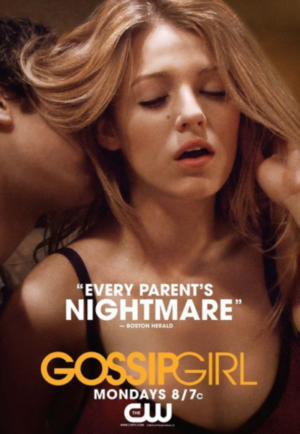When Gossip Girl‘s first episode aired on September 19, 2007, the Bush-drenched United States could never have anticipated just how “scandalous” the ads promoting the show would be. Perfecting a marketing technique that Madonna had long ago established after her nude photos were published against her will in Playboy and Penthouse, Gossip Girl‘s PR team decided the best way to fight criticisms about its inappropriateness was to use those very criticisms as advertising.
“Very bad for you,” as stated by The San Diego Union Tribune, became the caption for Chuck Bass (Ed Westwick) feeding a cherry to Blair Waldorf (Leighton Meester) in one ad, while Serena Van Der Woodsen in the throes of ecstasy with one of her many suitors featured the previously damning Boston Herald assessment, “Every parent’s worst nightmare.” Just what, exactly, the reviewer in that case thought constituted a worst nightmare entailed is unclear. After all, what parent shouldn’t want his or her child to live in the lap of luxury that Serena and Blair do (present tense, because all TV characters are living the same lives eternally)? Then again, with power and wealth comes apparent sluttiness.
Though Cecily von Ziegesar’s series of books tended to be far more dramatic in their distinct “YAness,” show creators Stephanie Savage and Josh Schwartz did plenty to amp up the sordid factor with as many sexually charged scenes as the CW (always known for teen drama programming innovation) would allow. Though Gossip Girl would consistently be the type of show that was “a matter of taste” (and not, say, collectively torn apart by the masses the way mother! is), it was through the blitzkrieg of unique marketing that they attracted a large audience in the first season.
In yet another ad, a scene of Blair making out with Nate (Chace Crawford) in a pool warranted The New York Post‘s “A nasty piece of work” judgment. And oh, how that tantalized tweens and teens trying to hide their viewing from their parents all the more (it’s true, suburban kids have it the hardest with repression).
Although Gossip Girl would eventually jump the shark around the time Lady Gaga made a cameo in Season Three–and definitely by the time Blair was married to the prince of Monaco in Season Five–loyal viewers would never forget the true scandal glory days of Season One in 2007, as thoroughly enhanced by what the over forty set might call “a titillating marketing campaign.” In retrospect, however, the ads look like little more than the type of covers that appear on 90s era bodice-ripping narratives by Danielle Steel. No one said scandals were timeless, or, apparently, the Manhattan contempt for Brooklyn that has since done a role reversal.





















